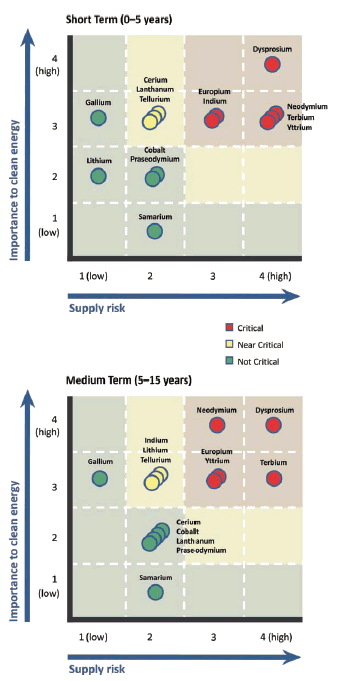Energy Elements
May 11, 2011
Scientists in the
laboratory rarely think about the cost of the
materials they're using. It's only when the
engineers take over and need to transform laboratory discoveries into scalable and affordable products that price matters.
One
director for whom I worked had a
rule of thumb that the high purity laboratory
chemicals we used for our crystal growth cost about five to ten dollars per gram, no matter what they were, since most of the expense is in
purification and stocking of small quantities. This is a little low for
gold (presently about $50 a gram), but fortunately a little high for most other elements.
There's a lot of activity in materials for
renewable energy and
energy efficiency. Important materials research areas are
catalysts,
photovoltaics and
permanent magnets. Many of these materials have a
rare earth component. In a
previous article (Rare Earth Shortage, June 21, 2010), I've described how
China controls to world market in rare earths and has been limiting exports of these elements.
The
American Physical Society (APS) and the
Materials Research Society (MRS) have published a report, "Energy Critical Elements: Securing Materials For Emerging Technologies." [1-2] This report highlights the importance of the following extensive list of
chemical elements important to energy technologies:
The report makes special note of the following seven elements.
| Tellurium | Used in solar panels |
| Germanium | Used in solar panels |
| Platinum | Used in automotive catalytic converters, and in fuel cells |
| Neodymium | Used in permanent magnets for wind turbines and hybrid cars |
| Lithium | Used in wind turbines and lithium-ion batteries for hybrid cars |
| Rhenium | Highest melting point metal used in advanced turbines and jet engines |
| Terbium | An important phosphor for compact fluorescent light bulbs |
The APS/MRS report calls for
research and development on
recycling, especially in product design for recycling. Most products that use energy critical materials have little recycling capability at present.[1-2]
Research and development is also encouraged on possible substitute materials. Attention to material efficiency, that is, producing devices from as little critical material as possible, would help. Aside from advocating reduced concentration in certain applications, the APS/MRS report also recommends replacement in non-critical applications and
lifestyle adaptations.[1-2]
Not unexpectedly, the APS/MRS report highlights specific government action on helium, which is unique and permanently lost to the atmosphere if not captured from
natural gas as it's extracted.[1-2] I reviewed the helium supply problem in a
previous article (The Helium Economy, July 9, 2010).
The rare earth elements figure prominently in a
US Department of Energy, December, 2010, report on Critical Minerals.[3] This report highlights as "most critical" the rare earth elements, dysprosium, neodymium, terbium, europium and yttrium. Indium is also named as a most critical material.

Criticality matrices for elements used in advanced technology. Short term and medium term risks are shown.
Critical Minerals Strategy (US Department of Energy, December, 2010) [3]
There are a number of reasons for a material's scarcity.
• It's found in very low concentrations in the Earth's crust (e.g., tellurium and rhenium).
• It's poorly poorly concentrated in ores, or concentrated to an extent that makes extraction expensive (e.g., germanium)
• It's not found in US ores (e.g., indium).
Tellurium and indium are obtained only as byproducts of other ore refining. Tellurium is a byproduct of
copper production, and indium is a byproduct of
zinc production. You wouldn't mine more copper just to get more tellurium.
References:
- Robert Jaffe, Jonathan Price, Murray Hitzman and Francis Slakey, "The Back Page - Energy Critical Elements," APS News, vol. 20, no. 4, March, 2010.
- Energy Critical Elements: Securing Materials for Emerging Technologies, A Report from the APS Panel on Public Affairs Committee and the Materials Research Society (MRS), February 2011.
- Critical Minerals Strategy (US Department of Energy, December, 2010).
Permanent Link to this article
Linked Keywords: Scientist; laboratory; material; engineer; director; rule of thumb; chemical; purification; gold; renewable energy; energy efficiency; catalysis; catalyst; photovoltaics; permanent magnet; rare earth; China; American Physical Society; Materials Research Society; chemical element; lanthanum; ruthenium; cobalt; cerium; rhodium; helium; praseodymium; palladium; lithium; neodymium; osmium; rhenium; samarium; iridium; silver; europium; platinum; gadolinium; terbium; dysprosium; gallium; ytterbium; germanium; lutetium; selenium; scandium; indium; yttrium; tellurium; research and development; recycling; lifestyle; natural gas; helium economy; US Department of Energy; Critical Minerals Strategy; copper; zinc.